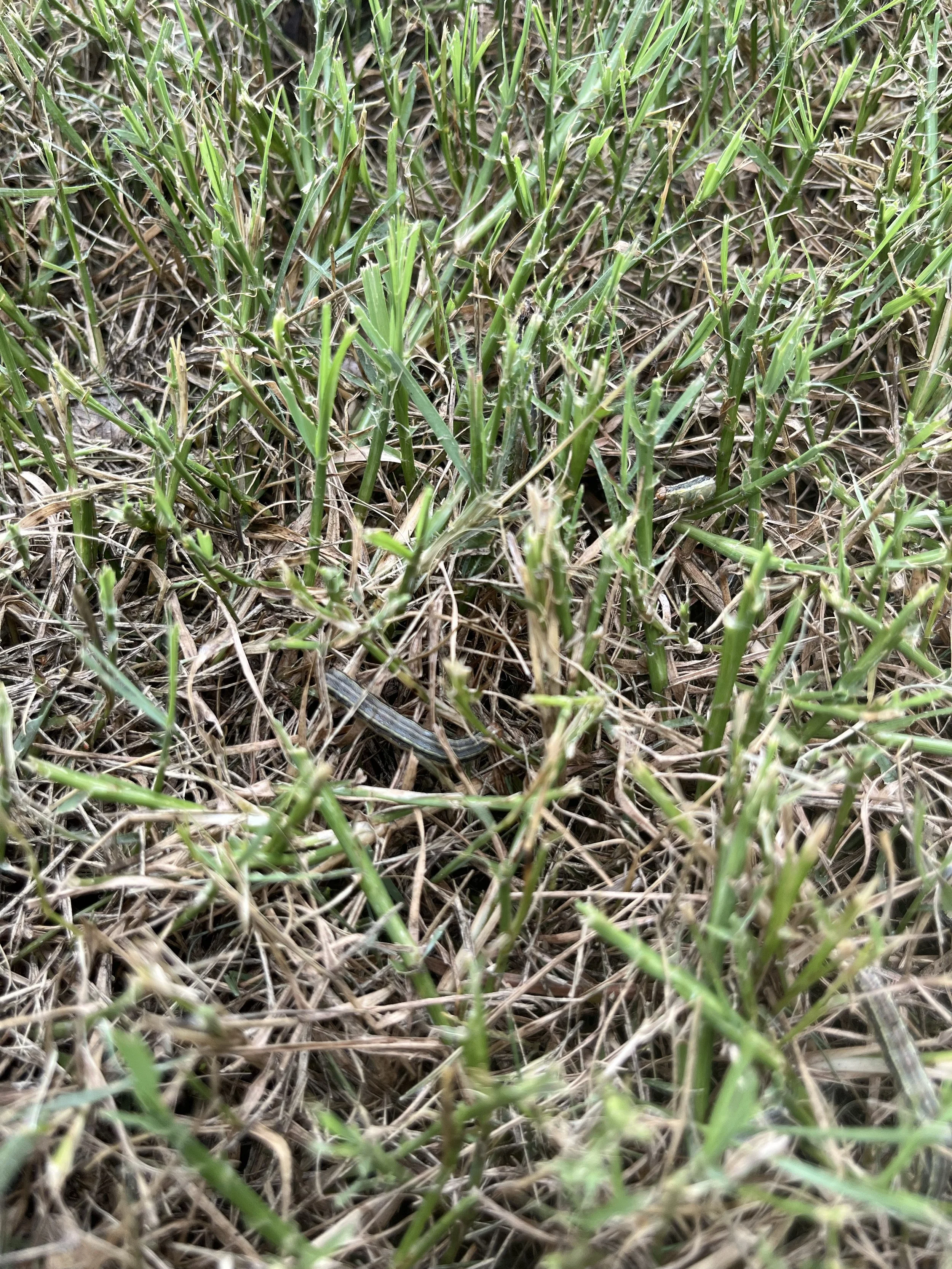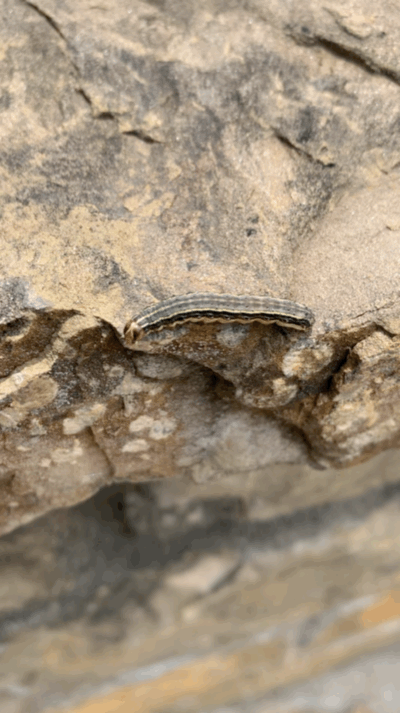The Return of the March of the Army Worms
This week has us feeling as though we are living in a sequel of 2021’s March of the Army Worms.
We mentioned army worms last week in our post “What’s Bugging Your Landscape”, as a turf damaging insect you should always be on the lookout for this time of the year.
You can always find a few army worms in the summer and fall. And like most insects, when populations are at normal levels, they are not a problem, and you may never notice them. But, when conditions are just right, you can see an explosion to turf damaging levels in a matter of days.
An army worm discovered Saturday feeding on a rural Edmond lawn.
What are the conditions that make us feel as though we are living in 2021 again?
Army worm eggs and worms have a higher survival rate when there is abundant moisture. Over the last 30 days, we have received 7” of rain. In 2021, during the same period, we also received an abundance of rainfall.
The first sightings of damaging army worm populations in 2021 were on the perimeters of the metro. With each generation of army worms in the summer of 2021, populations increased and lawn damage increased deeper into urban areas. This week, army worm activity was heavy around the perimeter of the metro area.
The mature Army Worm is 1 1/2” long, green to brown in color, with stripes down each side.
What is an army worm?
The adult form of an army worm is a light gray-white moth with mottled wings with a 1 ½” wingspan. Because army worms do not overwinter in our climate, the moths migrate from the Gulf Coast and Mexico each year arriving in our area in late June.
Each moth can lay over 1,000 eggs.
By early July the first generation of eggs have hatched, and the caterpillars go on a feeding frenzy that lasts 2-3 weeks.
Early caterpillars are green and very small and don’t cause any damage until they reach 1”. Quickly, they grow into a brown, almost black, 1 ½” long caterpillar with black and reddish-brown stripes on each side of the body and small black spots on the top. Their distinctive mark is an inverted “Y” on the front of the head.
At the end of the 2-3 week feeding period, the worm burrows 1” into the soil and enter the pupal stage. 7-10 days later they emerge from the soil as a moth and the life cycle starts all over.
The average entire life cycle lasts about 28 days. There can be 4 to 5 overlapping generations from July through early November, or until we have our first hard freeze.
Again, army worms are always present in our summer lawns and landscapes. When populations are normal, you may never know they are there. But, with the right conditions we can see an explosion to turf damaging levels in a matter of days.
How many Army Worms can you see in this picture? Their green to brown color makes them hard to spot.
While standing in this area while Army Worms were actively feasting, I had the sensation that the lawn was moving moving.
What is the typical host plant?
The army worm feeds on a wide variety of plants. They prefer any leafy, soft plant with plenty of moisture in the leaf. They love alfalfa and bermuda hay fields and all turf grass varieties.
For home lawns in our area, typically by the time we get to July, bermuda lawns are looking their best and fescue lawns are starting to enter their summer off season. So, it is common for army worms to prefer bermuda lawns over fescue lawns. In 2021, fescue lawns were thriving in July due to the abundance of moisture and cooler than normal temperatures. At the same time bermuda lawns were lagging behind. The result was lawns where army worms wiped out the fescue and skipped the bermuda completely in favor of moving to another lawn with fescue. So far this summer with both bermuda and fescue both doing well, army worms are feeding on both types of turf.
If you have a healthy, growing, green turf of any variety, your lawn may be a host location for army worms.
Will army worms kill a lawn?
Army worms are primarily surface feeders. Small to moderate infestations will consume the leaves of the plant and the lawn will recover over time with sufficient moisture and fertilizer. In large numbers, the worms will consume the crown of the plant and are capable of killing a lawn.
How do you know if you have army worms?
Because of how widespread and large the current population is, daily or at least every other day, inspection of the lawn is important. Early detection is the best control.
When army worm population are high, you may only have to look at your sidewalks to see them marching to the next blade of grass.
Early signs of army worm damage will appear as drought stress. Don’t dismiss areas that you think may just not be getting enough water.
Stand in the area that looks stressed. If the population is heavy enough, you will have the sensation that the grass is moving.
Still not sure? Get down on your knees and inspect the area. Because of their green to brown color, the worms can be hard to spot while standing.
Still don’t see any worms? Test the area with a soap flush. Mix 1 teaspoon of a lemon scented dish soap in 1 gallon of water. Pour over the area. If you have army worms, they will come to the surface. 2 to 3 worms per square foot, you need to treat.
Army worms feed heaviest in the evening, night, and early morning. They often are hard to find in the middle of the day.
Another clue you may have an army worm problem - Have you noticed an abundance of moths while walking across your lawn?
Take a stroll around your lawn today. If you see an abundance of moths you need to treat your lawn for army worms.
Check leaf blades in areas where the turf is browning. If your blades look like this one with jagged edges, you have Army Worms.
How important is frequent inspection? I mowed my lawn on Thursday. This area of the lawn always struggles with brown patch in the heat of the year because of low air circulation. Yesterday afternoon I walked the lawn checking for declining areas When I got to this area it looked a little worse than it did two days ago. Then I saw something move. Being late afternoon I couldn’t find any army worms even on my hands and knees.
I decided to do a soil drench with soapy water. I mixed a teaspoon of scented dish soap in one gallon of water.
I slowly poured the water in a one to two square foot area.
If there are army worms in the area, they will begin to move after the soapy water solution is poured over the area.
How do you control army worms?
A quick response is important. Army worms can wipe out a football sized lawn in 2 days.
Treatment when worms are small before they become heavy feeders is best. The army worm consumes 80% of their total consumption in the last two days of their worm stage.
Any insecticide labeled for caterpillar control in turf will be effective.
When making any application remember, the label is the law. Always read and follow all label instructions.
After treatment, keep up regular inspections. With a 4-week life cycle and overlapping generations, they continue to be proactive in watching for increasing populations of army worms.
Army Worms are fast movers.
This spot in a bermuda lawn appeared to be lack of water, but while inspecting the area I discovered army worms.
This bermuda lawn had a similar browning area as the last lawn. But after not finding any worms, I checked the irrigation and discover a head that was not working and the discoloration was a watering issue.
Will your lawn recover?
If the worms only eat the leaves, the lawn will recover. If they destroyed the crown, there is a possibility the lawn will not recover.
If you have a bermuda lawn, continue normal watering and fertilizing. There is still time for the lawn to return to a healthy condition before the end of the growing season.
For fescue lawns, recovery will be slower and will be delayed until we see cooler temperatures. This is already the most stressful time of the year for fescue. The best time to reseed fescue is September through October. If you experience army worm damage on your fescue lawn, plan on overseeding this fall.
Inspect your lawn today!
If you see any signs of army worms or turf damage, call (405)367-3873 or respond to this email.
Lorne Hall
Hall | Stewart Lawn + Landscape
(405)367-3873














